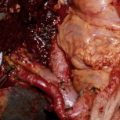Advances in percutaneous and endoscopic techniques have improved preoperative selection and optimization in patients with biliary and liver tumors, but are not without their own controversies. Selective rather than routine preoperative biliary drainage (PBD) should be employed, as PBD may be associated with increased infectious complications. Endoscopic ampullectomy (EA) offers advantages in morbidity and mortality over surgical approaches and should be the first line therapy for benign ampullary lesions. Ampullary cancers require pancreaticoduodenectomy. Effectiveness of percutaneous ablative techniques is dependent on tumor size and can be used as palliative therapy, as a bridge to transplantation, or, in select situations, as definitive therapy.
Key points
- •
Primary tumors of the bile ducts and liver often carry unfavorable prognoses and present several clinical and therapeutic challenges.
- •
Advances in percutaneous and endoscopic techniques have improved preoperative selection and optimization, as well as offering alternatives to traditionally morbid surgical therapies.
- •
However, these advances are controversial and include questions about the role of routine preoperative biliary drainage, endoscopic versus surgical resection of ampullary tumors, and the use of ablative techniques to treat primary liver tumors.
Stay updated, free articles. Join our Telegram channel

Full access? Get Clinical Tree




